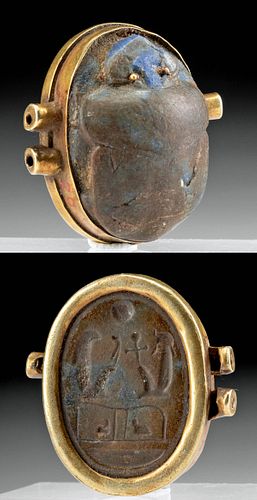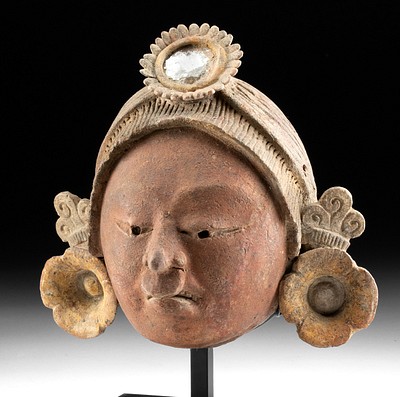Translated Egyptian Paste Glass Scarab Amenhotep III
Lot 5b
About Seller
Artemis Fine Arts
686 S Taylor Ave, Ste 106
Louisville, CO 80027
United States
Selling antiquities, ancient and ethnographic art online since 1993, Artemis Gallery specializes in Classical Antiquities (Egyptian, Greek, Roman, Near Eastern), Asian, Pre-Columbian, African / Tribal / Oceanographic art. Our extensive inventory includes pottery, stone, metal, wood, glass and textil...Read more
Categories
Estimate:
$14,000 - $20,000
Absentee vs Live bid
Two ways to bid:
- Leave a max absentee bid and the platform will bid on your behalf up to your maximum bid during the live auction.
- Bid live during the auction and your bids will be submitted real-time to the auctioneer.
Bid Increments
| Price | Bid Increment |
|---|---|
| $0 | $25 |
| $300 | $50 |
| $1,000 | $100 |
| $2,000 | $250 |
| $5,000 | $500 |
| $10,000 | $1,000 |
| $20,000 | $2,500 |
| $50,000 | $5,000 |
| $100,000 | $10,000 |
| $200,000 | $20,000 |
About Auction
By Artemis Fine Arts
Jul 14, 2022
Set Reminder
2022-07-14 10:00:00
2022-07-14 10:00:00
America/New_York
Bidsquare
Bidsquare : Exceptional Antiquities Ethnographica Fine Art
https://www.bidsquare.com/auctions/artemis-gallery/exceptional-antiquities-ethnographica-fine-art-9692
Museum-worthy examples of classical antiquities (Egyptian, Greek, Roman, Near Eastern), Viking, Far East / Asian, Pre-Columbian, African / Tribal, Oceanic, Native American, Spanish Colonial, Fossils, Ancient Jewelry, Fine / Visual Arts, so much more! Artemis Fine Arts info@artemisgallery.com
Museum-worthy examples of classical antiquities (Egyptian, Greek, Roman, Near Eastern), Viking, Far East / Asian, Pre-Columbian, African / Tribal, Oceanic, Native American, Spanish Colonial, Fossils, Ancient Jewelry, Fine / Visual Arts, so much more! Artemis Fine Arts info@artemisgallery.com
- Lot Description
Ancient Egypt, New Kingdom, 18th Dynasty, reign of Amenhotep III, ca. 1388 to 1351 BCE. A lovely scarab formed from sodalite-based paste glass of ovoid form exhibiting a fragmentary clypeus, a bulging thorax, gently incised elytra with triangular notches along the top, and thick legs tucked beneath the body. The eyes are inset with petite gold pins that create a wondrous visual effect against the cobalt blue glass, and the entire insect is surrounded by a 66.81% gold setting featuring 3 cylindrical string tubes. The underside of the scarab is incised with several hieroglyphs including a sun disk, 2 figures facing each other, and a hebsed symbol. When translated the hieroglyphs read, "Anx nb-mAat-re nb Hb-sds/Hb(.w)-sd" or "May Neb-maat-re live, the master of the Sed-festival(s)." The name Neb-maat-re is the prenomen of Pharaoh Amenhotep III. This scarab was likely buried with a mummified individual based on the brown-hued darkening of the blue paste glass. Size: 1.27" L x 1.23" W x 0.57" H (3.2 cm x 3.1 cm x 1.4 cm); gold quality: 66.81% (equivalent to 15K+)
Scarabs were important symbols in ancient Egypt, as the beetle was believed to represent a divine manifestation of the morning sun, the deity Khepri, whose name was comprised of the scarab hieroglyph and was understood to roll the morning sun disk over the eastern horizon precisely at daybreak. Amulets of the scarab were immensely popular for over a thousand years in ancient Egypt, as the scarab was a symbol with immense staying power, akin to that of the Christian cross. Scarabs were worn and carried by the living, and by the time of the Late Dynastic Period, they had also become part of the increasingly elaborate ensemble of items placed with the deceased for their eternal protection. The blue hues of the paste glass shown here were intended to symbolize the regenerative powers imbued within the waters of the Nile River.
Provenance: private Southern California collection, USA, bestowed 2006; ex-private Los Angeles, California, USA collection, acquired before 2006; ex-Hesperia Auction, New York, USA, November 27, 1990, Lot 59, # 10
All items legal to buy/sell under U.S. Statute covering cultural patrimony Code 2600, CHAPTER 14, and are guaranteed to be as described or your money back.
A Certificate of Authenticity will accompany all winning bids.
PLEASE NOTE: Due to recent increases of shipments being seized by Australian & German customs (even for items with pre-UNESCO provenance), we will no longer ship most antiquities and ancient Chinese art to Australia & Germany. For categories of items that are acceptable to ship to Australia or Germany, please contact us directly or work with your local customs brokerage firm.
Display stands not described as included/custom in the item description are for photography purposes only and will not be included with the item upon shipping.
#170610Both the scarab and the gold components are ancient; no modern materials are present. Loss to one gold string tube on one side of gold setting as shown. Chipping and damage to scarab's clypeus, with softening to some finer details and hieroglyphs, light encrustations within some hieroglyphs and around bezel border and eyes, otherwise in great condition. Nice preservation to most hieroglyphs. Old inventory number written in red pigment on side of gold setting.Condition
- Shipping Info
-
All shipping is handled in-house for your convenience. Your invoice from Artemis Gallery will include shipping calculation instructions. If in doubt, please inquire BEFORE bidding for estimated shipping costs for individual items.
-
- Buyer's Premium



 EUR
EUR CAD
CAD AUD
AUD GBP
GBP MXN
MXN HKD
HKD CNY
CNY MYR
MYR SEK
SEK SGD
SGD CHF
CHF THB
THB














